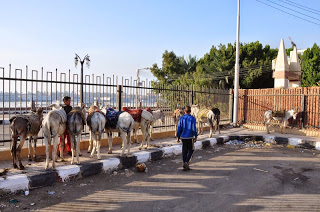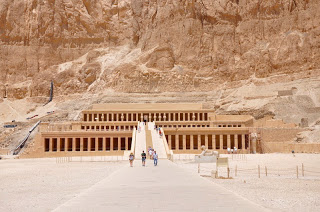As I continue recounting the tales of my recent journey to Egypt, I want to also continue to thank G Adventures for inviting me on this trip, and showing me aspects of the country that I didn’t experience on my first visit more than a decade ago. If you happen to find these stories intriguing, and you’d like to visit Egypt yourself, you could do a lot worse than joining G’s Absolute Egypt tour.
The 16-day itinerary takes you from the boisterous and chaotic streets of Cairo, to the historic cities of Aswan and Luxor, and into the heart of the Sahara Desert and beyond. It is an all-encompassing trip that will show you everything that the country has to offer, including plenty of things that you never expected.
In my previous post, I highlighted a few of the other ancient wonder of Egypt. We all know that the Pyramids and Sphinx are highlights of any visit to the Middle Eastern country, but there are a number of other incredible sites to take in as well, including the magnificent structures at Abu Simbel and the amazing Temples of Karnak and Luxor.
But even those places are just scratching the surface of the historical sights and monuments than Egypt has to offer. In fact, there are literally hundreds of other places to explore, and travelers could spend a lifetime trying to take them all in.
But one of the places that is a “must do” while in the country is the Valley of the Kings and Queens. For more than 500 years this site, which is located not far from the city of Luxor, was the designated resting place for the pharos. Over that period more than 63 tombs were constructed there, some very elaborate in their design.
Inside were placed the bodies of Egypt’s rulers, along with all of the items they would need to successfully see them through to the afterlife. The chambers were intricately painted with brightly colored images and hieroglyphs, and the tombs were no doubt filled with a stunning amount of gold and other precious items.

This particular valley was chosen for two reason. First, it happened to fall in the shadow of a mountain that bares an uncanny resemblance to a pyramid, which the Egyptians were no longer building at the time. And secondly, it was remote enough that it was thought that it would prevent tomb robbers from looting the valuables hidden inside.
Ultimately that hope was futile, as all but one of the tombs was long since emptied before they were later discovered by archaeologists. That single undisturbed tomb belong to King Tutankhamun, a boy pharaoh how was incredibly insignificant in Egyptian history. None the less, his golden mask and sarcophagus continue to mesmerize visitors to the Egyptian Museum in Cairo to this day.
On the day I visited the Valley of the Kings and Queens, we were up bright and early for a unique departure. Unlike most travelers, my group wasn’t simply driving to the Valley. Instead, we chose to visit it the same way that the ancient Egyptians did – on the backs of donkeys.
So, we set off not long after dawn, first crossing the Nile in a small boat, before meeting our trusty steeds on the other side of the water. The donkey’s seemed even less thrilled at the prospect of beginning the day with a ride, but they dutifully allowed us to mount up, and began heading towards our ultimate destination.
Over the next hour or so we rode through the streets and backroads of Luxor along its west bank. Along the way we passed through parts of town that were only just beginning to wake, and eventually we wander out into the countryside, where farms and homesteads dotted the landscape.
It was actually a very pleasant way to take in the Egyptian countryside, despite the growing pain in my posterior. Thankfully, my mount elected to behave the entire length of the ride, but some of my companions were forced to endure the more obstinate attitude that donkeys are often famous for.
Eventually our morning jaunt came to an end, and we were forced to abandon our mounts in favor of more modern transportation into the Valley itself. Loading up in 4×4 vehicles we drove off into the hills to cover the short distance that remained. Shortly there after, I found myself wandering through ancient tombs that were adorned with an amazing number of brightly painted images.
The colors inside those tombs were so well preserved it was almost as if they had been painted yesterday. Unfortunately, none of us were allowed to take photos, so you’ll just have to use your imagination. But if you’ve ever seen a Mummy movie, you’ll have at least an idea of what the chambers looked like.
Surprisingly enough, archaeologists operating inside the Valley of the Kings and Queens continue to find new tombs there. The latest was discovered back in 2008, but there are indications that there are still more to be found. Whether or not any of them will reveal a treasure trove on par with King Tut’s remains to be seen, but considering how thorough the tomb raiders of the past were, it seems unlikely.
Temple of Hatshepsut is located not far away, and was built to not only line up with the Valley itself, but also Karnak Temple backing the city of Luxor.

After spending the better part of the morning in the Valley, we loaded up once again and headed out for another ancient structure. The
The Temple of Hatshepsut is one of my favorites because it was carved out of the side of a mountain. It features an impressive number of pillars and chambers. It was dedicated as a monument to the god Amun-Ra, and even though it has been destroyed three times over the centuries, it remains an impressive site none the less.
The Temple was built to honor Egypt’s only female pharaoh. Hatshepsut rose to power after her brother died at a premature age, and she was able to hold on to the throne for more than 20 years by disguising herself as a man.
During that period, she established trade routes across Africa, explored the continent far and wide, and managed to expand the Egyptian empire. But she was overthrown by her nephew who returned to claim the throne, and later had her visage removed from all monuments that bore her name. At the time, it was impossible for a woman to rule Egypt, and the feud between the two nobles was a bitter one indeed.
After leaving Hatshepsut’s temple we set off back to Luxor, but not without making one more stop to take in the Colossi of Memnon. This two massive statues mark the entrance of what was once a large temple, but little remains of the place now.
The ancient site fell in the flood plane of the Nile, and as a result it was destroyed over the years. There is not much to see there now either, save the crumbling remains of what were once two magnificent statues.

One of the highlights of the G Adventure trip was getting the opportunity to visit the homes of several locals, and have a traditional meal there. After a full day of touring these monuments, we stopped for lunch with a local family. They provided us with an excellent meal with a variety of vegetables, meats, and flat breads, while also giving us a chance to see what daily life is like in modern Egypt.
It was a quiet, simple affair, but an intriguing one none the less. The house was filled with young children, all of whom were interested in the foreign strangers who had invaded their home. In the kitchen, the wives went to work preparing our meal, while several of the adult males served as our hosts. Afterward, we all gathered for a group photo outside the home, but not surprisingly the ladies didn’t join in.
With this final day of touring in Luxor behind us, my group prepared to set out for the desert. Soon we would leave the ancient wonders of Egypt behind in favor of its natural wonders instead. I was eager to embark on that stage of the journey, as it was a part of the country I hadn’t seen yet. While it was said to leave all of the monuments, temples, and tombs behind, the desert was calling, and I was ready to see what it would have to offer.
I would soon find out.
- Gear Review: The Xero Scrambler Mid is an Ultralight Hiking Shoe for Spring - March 1, 2023
- Gear Review: Yeti Roadie 48 Wheeled Cooler - August 18, 2022
- Kristin Harila Continues Pursuit of 8000-Meter Speed Record - August 16, 2022

Nice blog. Thanks for sharing with us such a post. Egypt is my favourite place. I have gone to Egypt and have visited Valley Of the Kings and Queens. Egypt has been such a fascinating place for travellers for decades. The Valley of the Kings was the royal cemetery for 62 Pharaohs and is located on the west bank at Luxor and the Valley of the Queens is an isolated cemetery, at the southern part of the vast necropolis of Thebes, on the west bank of Luxor. There are more information need to know about ancient Egypt. On my Egypt trip travels, talk, I had benefited to explore with Ask-Aladdin. Keep blogging..